
How to Create a B2B Content Marketing Machine
When I launched SaasRise in 2023, I didn’t realize how much of our future growth would depend on one simple idea: building a machine that produces high-quality content every single week. This is what I've learned.
Back then, I was like most founders — juggling a hundred priorities, writing a random newsletter when inspiration struck, and wondering why our outbound campaigns weren’t landing. Then one day, I looked at the data: the companies that consistently produced valuable, high-quality content once or twice a week were growing 2–4x faster than those who only published once a month.
That was the moment it clicked. Marketing isn’t about creating a post when you feel like it. It’s about creating a system that never stops producing — a machine that educates, engages, and nurtures your audience at scale.
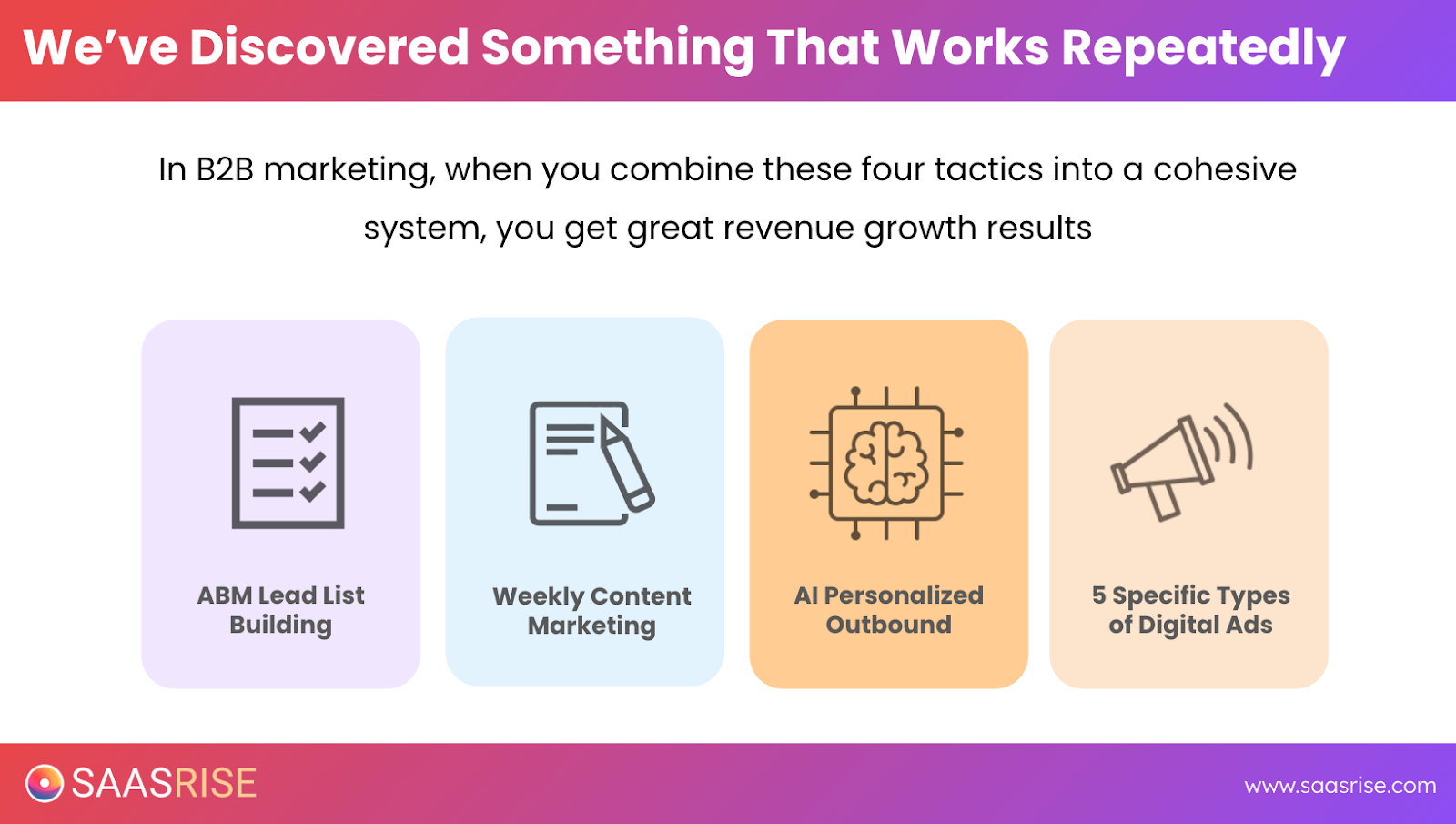
Today, I’ll walk you through exactly how we built our B2B Content Marketing Machine at SaasRise — a system that took us from 579,000 to 2.7 million content impressions per month in just 18 months, and helped grow our ARR from $100K to $300K per month.
Let’s dive in.
The Foundation: Audience, Message, Offer
Before you can create great content, you need clarity on three pillars.
First, your audience.
Who exactly are you talking to? You need a precise Account-Based Marketing (ABM) list of your target ICPs. At SaasRise, our clients usually work with ABM lists of 30,000 to 200,000 leads, built using tools like Apollo, LinkedIn Sales Navigator, ZoomInfo, Clay, or Instantly. Once you have the base list, enrich it with personal emails and phone numbers to double your ad platform match rates.
Second, your message.
What do they need to hear? Every piece of content should tie back to a real pain point or opportunity your ICP faces. Don’t write what’s trendy — write what’s truly helpful to them.
Third, your offer.
What action do you want them to take after consuming your content? A great content piece should move your audience one step closer to becoming a demo, trial, or paying customer.
Why Content Is the Core of B2B Growth
When we designed the SaasRise B2B Growth Program, we realized something critical: outbound and ads don’t work without great content.
If you’re only sending cold emails or running paid ads without valuable content behind them, you’re missing the credibility that turns awareness into trust. Content is what powers brand omnipresence — the feeling that your company is everywhere your ICP looks.
Think of your marketing engine as a pyramid.
At the base is your product, followed by your audience, then your message and offer, and finally your distribution — outbound, ads, website, warm email, and video.
Your content is what connects all these layers together. It’s how you communicate value, build authority, and stay top of mind until your prospect is ready to buy.
The Million-Impression Rule
Every B2B brand should have one simple KPI for its marketing system:
1,000,000 content impressions per month within your ICP.
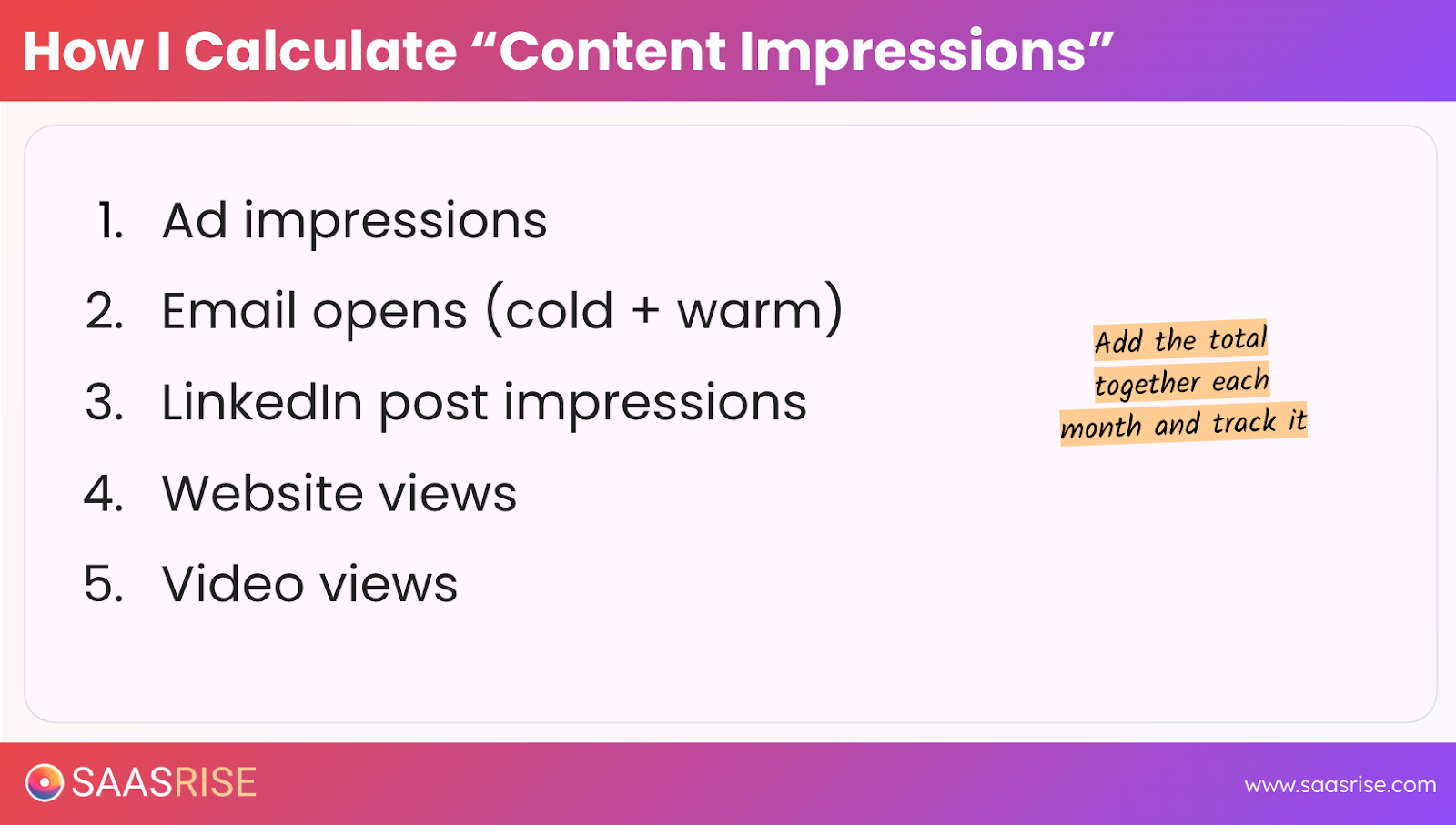
That number combines five key metrics: ad impressions, email opens, LinkedIn post and newsletter impressions, website sessions, and video views.
When we started tracking this at SaasRise, we were hitting just over 500K monthly impressions. Fast forward to today — 2.7M monthly impressions, consistent revenue growth, and a strong brand presence across every major channel.
When you cross the million mark, something magical happens: you blanket your market. Your ICP starts to see you everywhere — in their inbox, on LinkedIn, in search results, in retargeting ads, even on YouTube. That’s brand omnipresence. And it’s one of the most powerful growth levers in B2B.
How We Built Our Content Machine
Here’s how we built a system that runs every single week — even when I’m out of the office or spending time with my family.

Step 1: Create One Anchor Content Piece Per Week
At the core of the machine is what I call anchor content — one flagship piece of content per week. This can take many forms: a blog post, a webinar, a podcast interview, a customer case study, or a long-form video.
Your anchor content is the seed from which everything else grows.
When we first started, I blocked off Mondays from 10am to 1pm as my writing time. Every week, I wrote a 2,500-word article about SaaS growth, venture multiples, or marketing strategy. Later, I realized I could record my weekly training calls and turn those transcripts into polished blog posts using AI tools like ChatGPT and Wistia.
The key here is discipline. Every week, no matter what, one high-quality piece of content must go out.
Step 2: Repurpose Across Channels
Once you’ve created your anchor content, multiply its impact by repurposing it across all major channels.
Start by turning your main piece into a weekly email newsletter. Then publish the same content on your blog for SEO purposes. From there, adapt it into a LinkedIn newsletter, and then break it into smaller LinkedIn posts — short, 3,000-character versions that capture the main insights.
Next, convert your article into a short video summary. You can record it yourself or use an AI avatar with tools like Synthesia. Finally, use screenshots of your blog or video snippets as creative assets for retargeting ads on Meta or LinkedIn.
The process might sound like a lot, but with AI tools like ChatGPT, Riverside, and Veed, you can automate most of it.
Remember: AI should help you repurpose your expertise, not replace it. Don’t ask it to “write a blog post about ABM” from scratch. Instead, give it your own transcripts, customer insights, or webinar notes, and have it polish and format them for different platforms.
Step 3: Build a Weekly Routine
Consistency is everything. You need a clear, repeatable rhythm that your team can follow.
Here’s what works for us:
- On Fridays, we choose the topic for the upcoming week.
- On Mondays, we create the anchor content — whether that’s writing, recording, or scripting.
- On Tuesdays, we edit, fact-check, and design visuals.
- On Wednesdays, we publish to our blog and newsletter.
- On Thursdays, we repurpose the content for LinkedIn posts and thought leader ads.
- On Fridays, we analyze performance and brainstorm next week’s ideas.
The goal is to turn content creation into a habit — a weekly process that runs like clockwork.
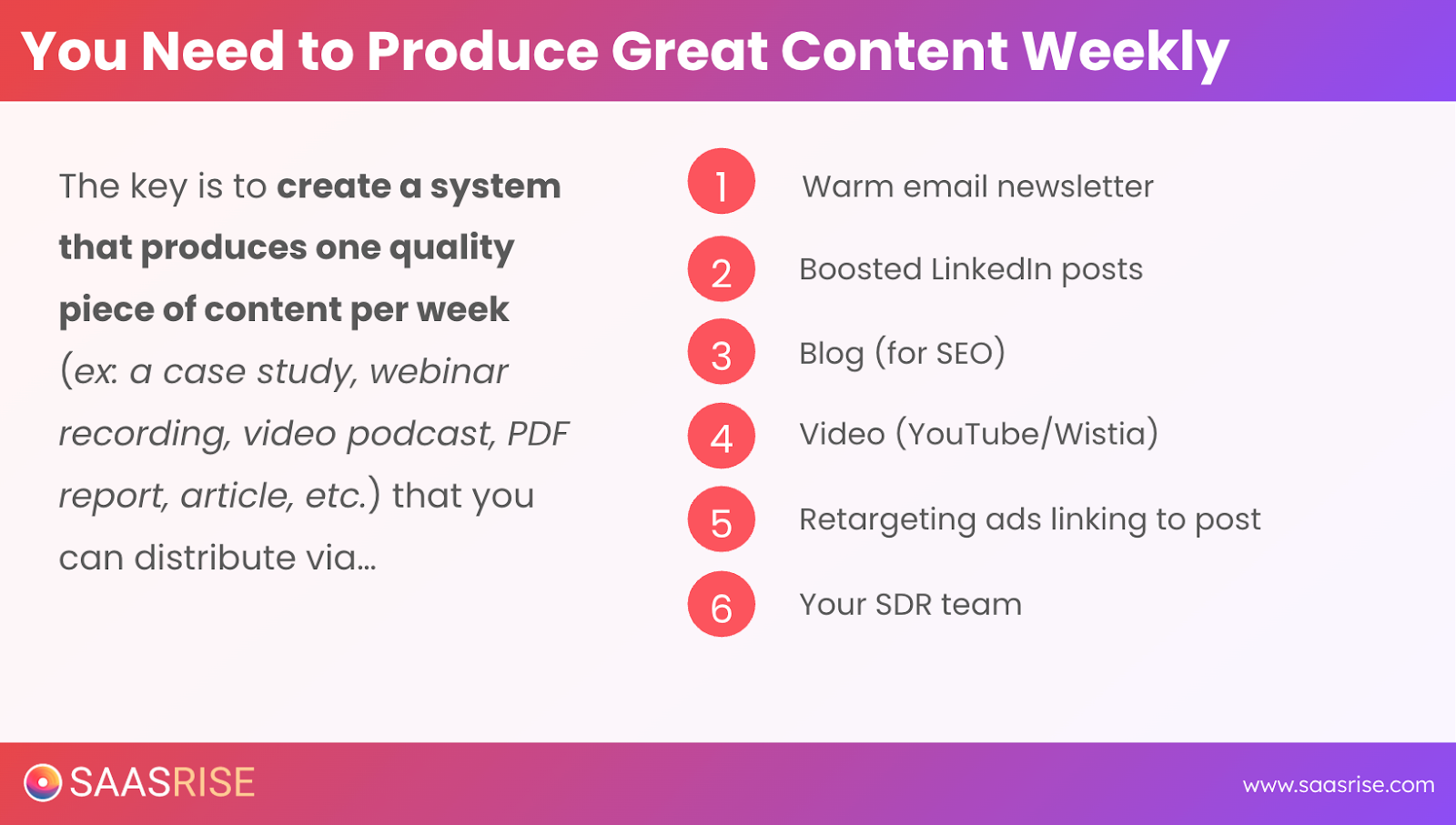
The People and Tools Behind the Machine
You don’t need a big team — just the right people and systems.
Start with a content owner.
This person manages the process week after week. It might be a founder, a head of marketing, or a part-time content marketer. At SaasRise, I hired Hector, an EA from Athena, and trained him to be our content operator. Today, he handles 80% of the execution — turning transcripts into polished posts, coordinating design, and scheduling distribution.
Then, assemble your tool stack.
For writing and editing, use ChatGPT, Claude, or Jasper.
For video, rely on Wistia, Synthesia, Riverside, or Veed.
For design, Gamma and Canva do wonders.
For email distribution, use Beehive, Brevo, or SendGrid.
For cold and warm outbound, use Instantly or SmartLead.
And for ads, focus on Meta, LinkedIn, and Google.
With one assistant and a few of these tools, you can maintain your entire content operation in just three to five hours a week.
Measure What Matters
Every company in our program tracks one key number: total monthly content impressions.
To calculate it, add up your ad impressions, email opens, LinkedIn post views, website sessions, and video plays.
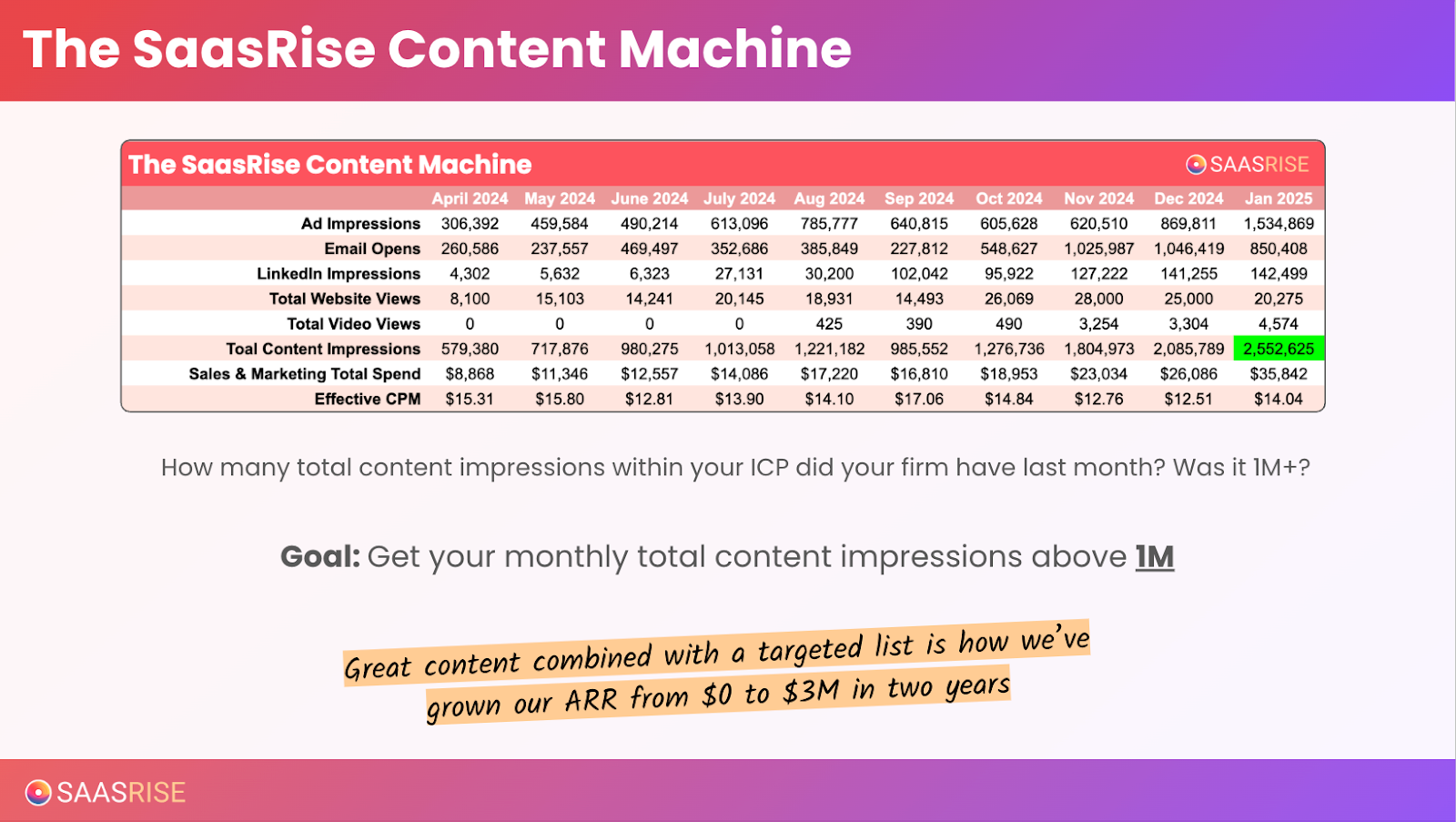
At SaasRise, here’s what that looked like in October 2025:
1.5 million ad impressions, 512,000 email opens, 484,000 LinkedIn impressions, and 200,000 website visits — for a total of 2.7 million monthly content impressions.
Once we crossed the one-million threshold in mid-2024, everything accelerated. Inbound demos increased, retargeting costs dropped, email open rates rose, and cold email reply rates improved. Simply put: the more we showed up, the more our audience trusted us.
The Surround Sound Strategy
One of my favorite case studies is Landon Ray, the founder of Ontraport.
After joining our program, he adopted this exact framework and rebranded it internally as the Surround Sound Strategy. His approach was simple: one high-impact topic per week, repurposed everywhere — email, blog, LinkedIn, community, and ads.
The results were immediate: a noticeable increase in qualified pipeline and inbound leads.
The lesson is clear — you don’t need to create more content. You just need a system that amplifies the right content in every channel where your ICP spends time.
The 9-Step Content Machine Framework
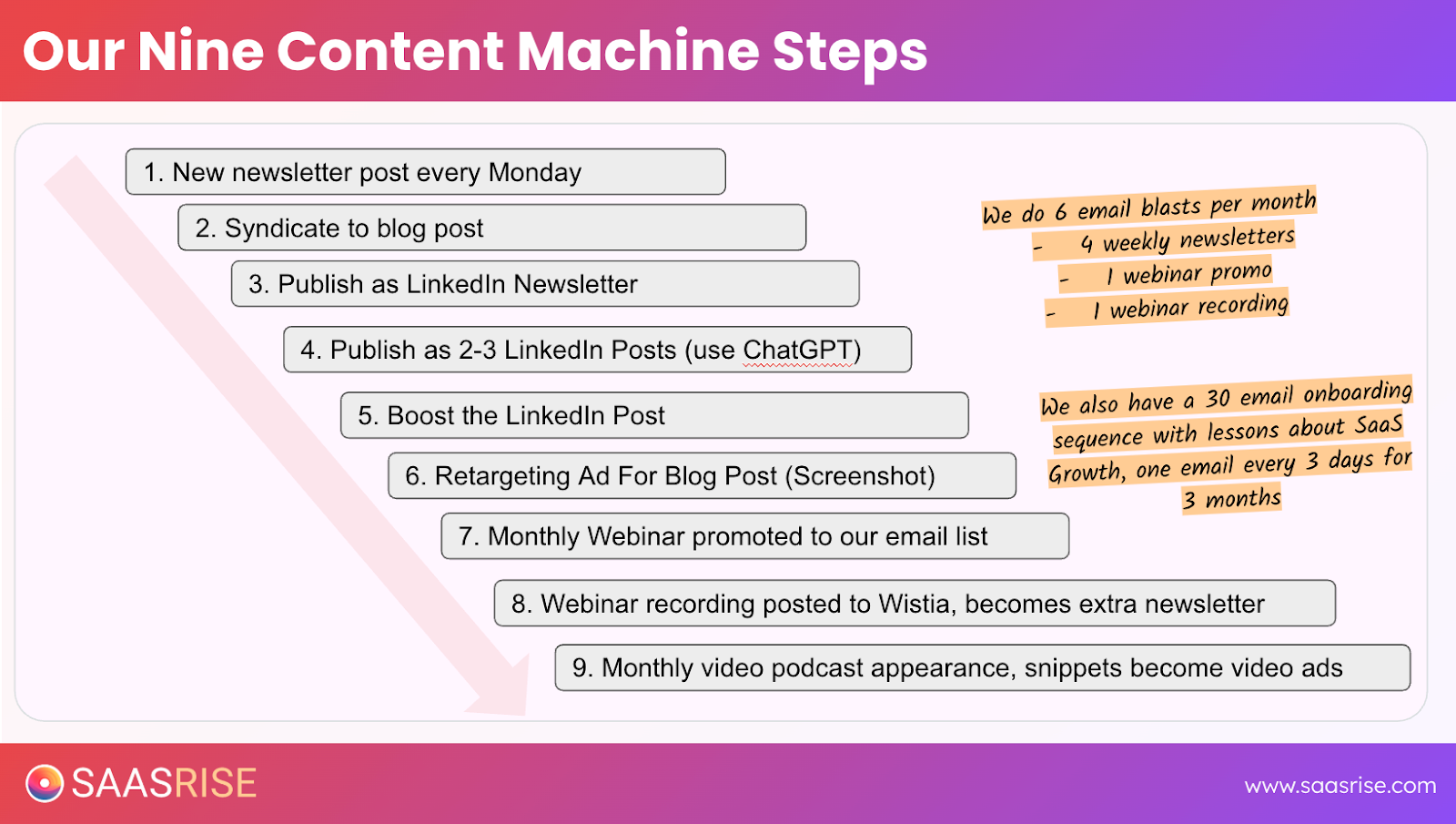
Here’s the full workflow we use at SaasRise, step by step:
- Create one flagship piece of content each week — written or video.
- Repurpose it into multiple formats: blog, email, social posts, and video.
- Publish it to your blog and email list.
- Syndicate it on LinkedIn as both a newsletter and short posts.
- Boost it with thought leader ads to expand reach.
- Retarget visitors with visual ads using screenshots of your post.
- Host your long-form videos on Wistia or YouTube.
- Clip short highlights using Riverside or Veed for use in ads.
- Add your best-performing content into automated email sequences for future leads.

Each week builds upon the last. Blog posts become newsletters, newsletters become social posts, posts become ads, and ads drive more visitors — feeding the cycle. That’s the compounding nature of the content machine.
Make Content Worth Your Prospect’s Time
The ultimate test of good content is simple:
Would your prospect actually take the time to read or watch it?
If the answer is no, don’t publish it.
To create content that stands out, share real stories and data. Write about specific challenges your customers overcame. Offer step-by-step playbooks. Keep your tone casual and human — founder to founder.
Avoid generic, AI-generated fluff. Focus on authentic insight, actionable advice, and relatable storytelling.
Using AI the Right Way
AI is an incredible accelerator — when used strategically.
At SaasRise, we use it in very specific ways:
- Uploading our Wistia recordings and turning transcripts into blog posts.
- Asking ChatGPT to rewrite transcripts into 2,500-word articles in a conversational, founder-style tone.
- Summarizing long-form posts into 3,000-character LinkedIn pieces.
- Using Riverside’s Magic Clips feature to automatically generate short 30-second videos for social media.
- Leveraging Synthesia to transform blog posts into short, high-quality AI-narrated videos.
The key is this: use AI to repurpose human expertise — not to replace it.
Leverage LinkedIn the Smart Way
Here’s one of the biggest lessons we’ve learned: people follow people, not logos.
That’s why at SaasRise, we post everything from my personal LinkedIn account, not the company page. Posts written by individuals — especially founders — get 10 to 20 times more engagement.
To win on LinkedIn:
- Post two to four times a week from your personal profile.
- Mix educational, story-driven, and promotional posts.
- Boost your top-performing posts with thought leader ads.
- Keep your tone authentic, direct, and conversational.
Over time, you’ll build what I call founder brand gravity — a level of credibility and visibility that draws prospects toward your company.
The Weekly Content Distribution Checklist
Each week, before wrapping up, make sure you’ve covered these steps:
- Publish your anchor content on the blog.
- Send it as a newsletter to your list.
- Post a shorter version on LinkedIn from your personal profile.
- Boost the post with a thought leader ad.
- Create a retargeting ad featuring a screenshot of your article.
- Post related clips on YouTube or Wistia.
- Add snippets to your automated nurture sequences.
- Track impressions and engagement across all channels.
By Friday, your content should be visible everywhere your ICP spends time — without you having to start from scratch each week.
Scaling Your Content Machine
Once the system is working, scaling becomes simple.
Start by hiring help — an EA, a ghostwriter, or a part-time content marketer. We work with a fantastic writer named Abeat, who creates 16 LinkedIn posts a month for $2,750. Next, double your publishing frequency from one to two pieces per week. Then, layer in video content, such as monthly webinars or podcasts.
Every webinar becomes a blog post, a newsletter, several LinkedIn posts, and dozens of video clips. Each month, your reach multiplies without additional effort.

Discipline Beats Ideas
Everyone loves the idea of creating great content. But only a few have the discipline to do it every week.
As Cristiano Ronaldo once said, “Anyone can have the plan. But without discipline, the plan doesn’t work.”
Marketing is no different. I can give you the playbook, the tools, and the system — but it’s your consistency that makes it real.
If you stay the course, three months from now you’ll have a functioning content engine. In six months, your brand will feel omnipresent in your market. In a year, your inbound pipeline will overflow.
In B2B marketing, consistency compounds.
The companies that publish weekly grow 2–4x faster — not because their products are better, but because they’ve mastered the art of staying top of mind.
Build your machine, and you’ll build your growth.

